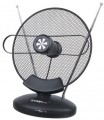UHF frequency range
The frequencies of the UHF range for which the antenna is designed. UHF includes frequencies from 300 MHz to 3 GHz, however, frequencies above 900 MHz are practically not used in terrestrial television broadcasting, so TV antennas cover only the lower part of UHF. Also note that some manufacturers indicate a general range for their models, without dividing it into VHF (see above) and UHF; in such cases, this range is also indicated in this section.
Antenna sellers generally choose to sell models that are compatible with local frequencies. Therefore, in general, the frequency range is a rather specific parameter that the average user rarely needs — except when buying an antenna in another country.
Output impedance
The internal resistance of the antenna to alternating current. The standard value for modern TV antennas is 75 ohms; it is this impedance that the connecting cable used to connect the antenna to the receiver should have — otherwise there can be no question of normal use.
Cable length
The length of the connecting cable supplied with the antenna (often non-detachable). Quite a lot of models come with a cable right away, which eliminates the need to purchase it separately. And knowing the length of the cable, you can evaluate whether it is enough to reach the TV without additional cables.

